 |
 |
 |
| |
Prevalence of and risk factors for low Bone Mineral Density assessed by Quantitative Computed Tomography in people living with HIV and uninfected controls
Very Low BMD More Frequent With HIV--But Not After Statistical Adjustment
|
| |
| |
17th European AIDS Conference, November 6-9, 2019, Basel
Mark Mascolini
Quantitative computed tomography (QCT) indicated a higher prevalence of very low bone mineral density (BMD) in 718 people with HIV in Denmark than in 718 matched HIV-negative controls [1]. But that association lost significance after statistical adjustment for other factors that can affect BMD, a result indicating that traditional osteoporosis risk factors drive the low-BMD difference between people with and without HIV. (previous AIDS associated with lower BMD).
People with HIV have higher rates of osteopenia, osteoporosis, and fractures than people without HIV, noted University of Copenhagen investigators who conducted this study. Research on BMD in people with versus without HIV usually relies on DXA scans to diagnose osteoporosis. But the Copenhagen team decided to use QCT for this analysis because it yields three-dimensional volumetric density measurements and permits separate measures of trabecular (porous) bone and cortical (denser outer) bone.
This cross-sectional study involved HIV-positive people 40 or older taking combination antiretroviral therapy and HIV-negative controls matched to the HIV group by age and sex. All CT imaging was done with the same scanner. The researchers measured volumetric BMD in 3 consecutive thoracic vertebrae and defined BMD as normal (T-score > -1), low (T-score -1 to -2.5), or very low (T-score
Median age stood at 52.2 in the HIV group and 53.8 in controls (P = 0.070), and proportions of men were 86.2% with HIV and 86.6% without HIV. The HIV group included a significantly higher proportion of current smokers (26.4% versus 12.6%, P < 0.001), drank less alcohol (7 versus 8 units per week, P = 0.001), and had a lower body mass index (24.7 versus 26.1 kg/m2, P < 0.001) and higher waist-to-hip ratio (0.94 versus 0.91, P < 0.001).
People had diagnosed HIV infection for a median of 15.8 years and took antiretrovirals for a median of 13.3 years. A large majority of people with HIV, 96.1%, had an undetectable viral load, 60.2% currently took tenofovir disoproxil fumarate, and 29.4% currently took a protease inhibitor.
Proportions of people in each BMD category differed by HIV status, with a higher proportion in the HIV group having very low BMD (17.2% versus 11.0%) and lower proportions with HIV having low BMD (32.3% versus 36.2%) or normal BMD (50.6% versus 52.8%) (P = 0.003). Unadjusted statistical analysis determined that people with HIV had two thirds higher odds of very low BMD (odds ratio [OR] 1.68, 95% confidence interval [CI] 1.24 to 2.27, P = 0.001). But that association lost statistical significance after adjustment for age, sex, smoking, alcohol, body mass index, physical activity, and ethnicity (adjusted OR 1.26, 95% CI 0.88 to 1.83, P = 0.210). Previous AIDS-defining disease, but no other HIV-specific factor, was associated with lower BMD.
In the multivariable analysis, every 10 years of age doubled the odds of very low BMD (aOR 2.13, 95% CI 1.76 to 2.57, P < 0.001), higher body mass index trimmed the odds of very low BMD (aOR 0.81, 95% CI 0.76 to 0.86, P < 0.001), and more smoking pack-years boosted the odds of very low BMD (aOR 1.01, 95% CI 1.01 to 1.02, P = 0.001).
Because traditional risk factors explained the higher rate of very low BMD in people with versus without HIV, the researchers underlined the need for "continued focus on effects of lifestyle factors on BMD and efforts to reinforce healthy ways of living . . . to prevent low BMD in people living with HIV, especially in those with previous AIDS."
Reference
1. Thomsen MT, Wiegandt YL, Gelpi M, et al. Prevalence of and risk factors for low bone mineral density assessed by central quantitative computed tomography in people living with HIV and uninfected controls. 17th European AIDS Conference, November 6-9, 2019, Basel. Abstract BPD2/2.
---------------

Reported by Jules Levin
17th European AIDS Conference, November 6-9, 2019, Basel
8th November 2019
17th European AIDS Conference, Basel, Switzerland
Magda Teresa Thomsen, MD
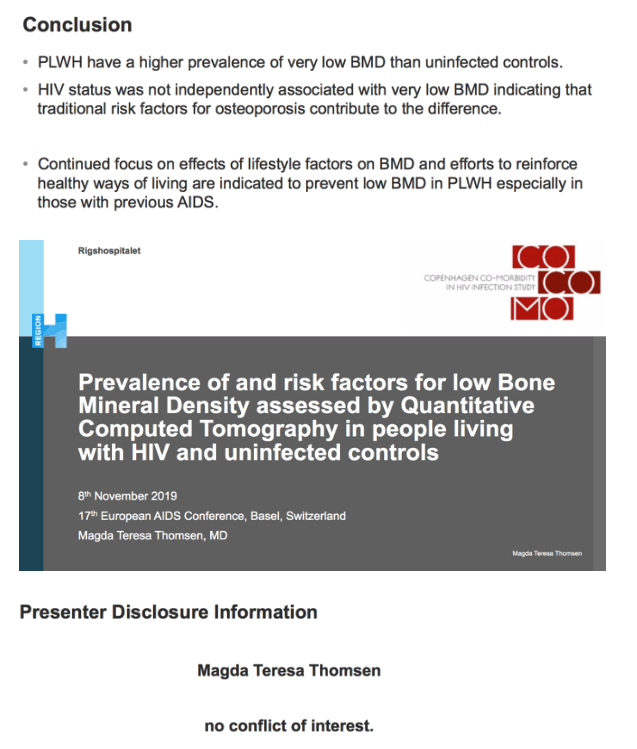
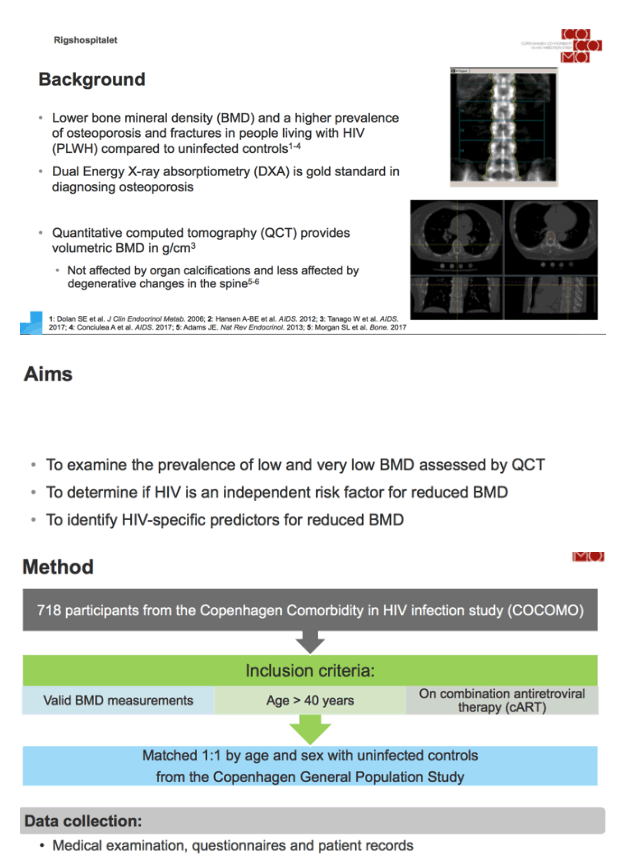
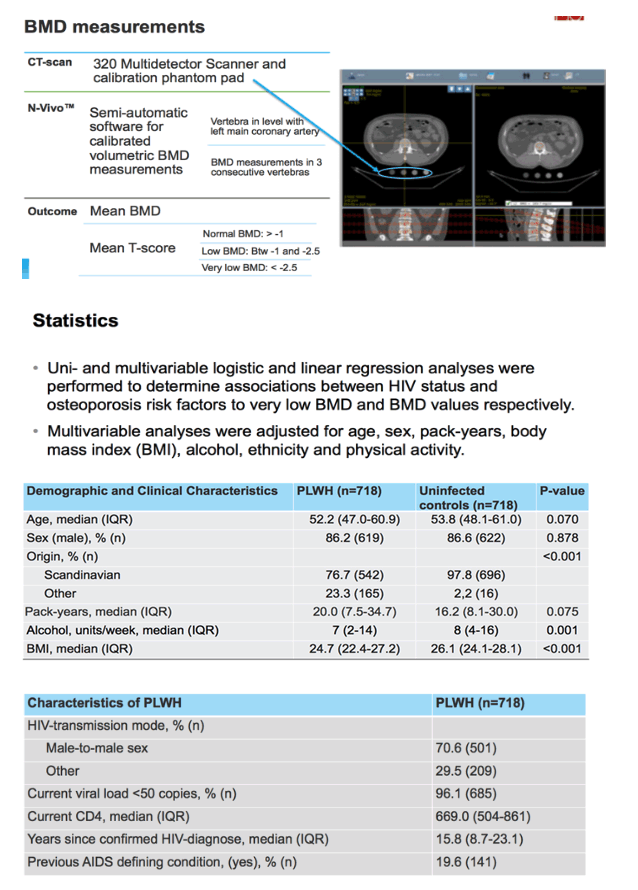
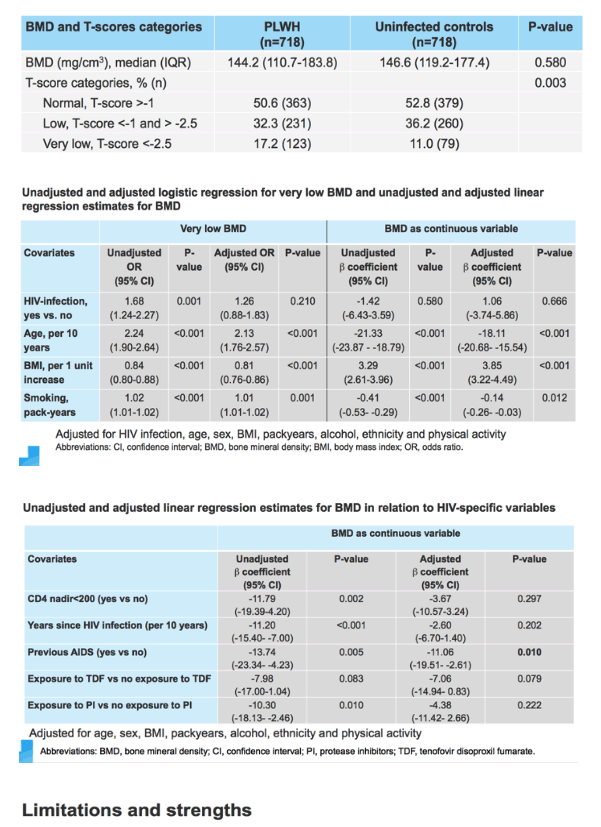
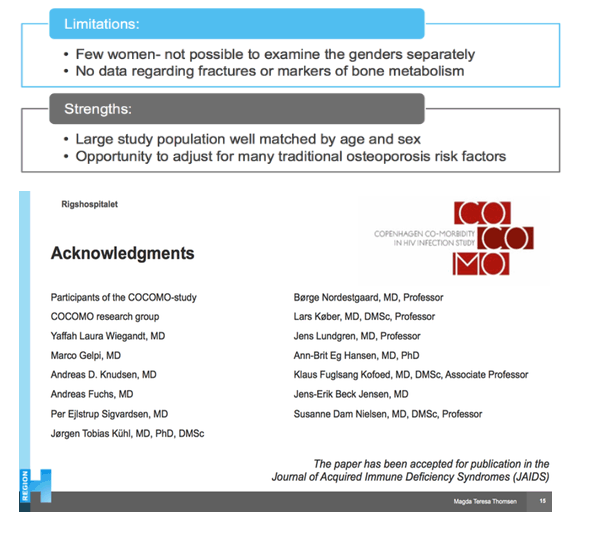
|
| |
|
 |
 |
|
|